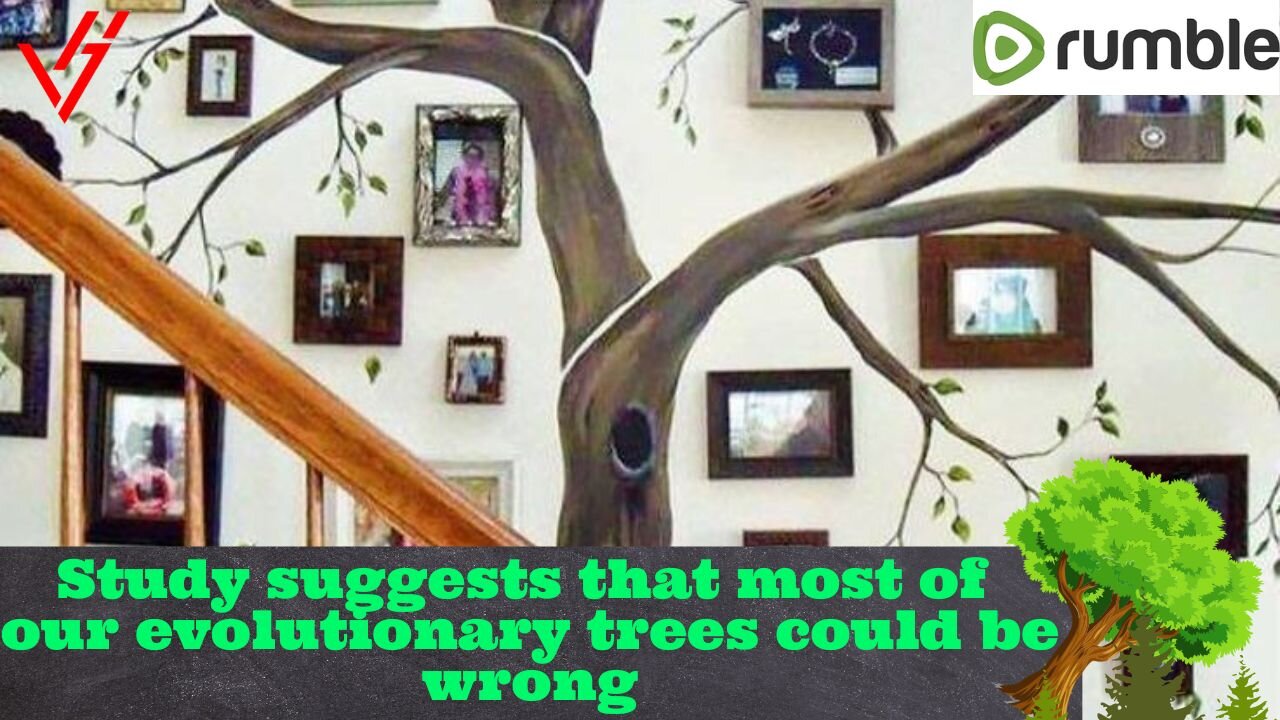Premium Only Content

Study suggests that most of our evolutionary trees could be wrong
00:00 - Study suggests that most of our evolutionary trees could be wrong
00:07 - 1 - The study:
New research led by scientists at the Milner Centre for Evolution at the University of Bath suggests that determining evolutionary trees of organisms by comparing anatomy rather than gene sequences is misleading. The study, published in Communications Biology, shows that we often need to overturn centuries of scholarly work that classified living things according to how they look.
Since Darwin and his contemporaries in the 19th Century, biologists have been trying to reconstruct the "family trees" of animals by carefully examining differences in their anatomy and structure (morphology).
However, with the development of rapid genetic sequencing techniques, biologists are now able to use genetic (molecular) data to help piece together evolutionary relationships for species very quickly and cheaply, often proving that organisms we once thought were closely related actually belong in completely different branches of the tree.
01:02 - 2 - Mapping:
For the first time, scientists at Bath compared evolutionary trees based on morphology with those based on molecular data, and mapped them according to geographical location.
They found that the animals grouped together by molecular trees lived more closely together geographically than the animals grouped using the morphological trees.
Matthew Wills, Professor of Evolutionary Paleobiology at the Milner Centre for Evolution at the University of Bath, says that "it turns out that we've got lots of our evolutionary trees wrong.
"For over a hundred years, we've been classifying organisms according to how they look and are put together anatomically, but molecular data often tells us a rather different story."
"Our study proves statistically that if you build an evolutionary tree of animals based on their molecular data, it often fits much better with their geographical distribution."
"Where things live—their biogeography—is an important source of evolutionary evidence that was familiar to Darwin and his contemporaries."
"For example, tiny elephant shrews, aardvarks, elephants, golden moles and swimming manatees have all come from the same big branch of mammal evolution—despite the fact that they look completely different from one another (and live in very different ways)."
"Molecular trees have put them all together in a group called Afrotheria, so-called because they all come from the African continent, so the group matches the biogeography."
02:27 - 3 - Discovery:
The study found that convergent evolution—when a characteristic evolves separately in two genetically unrelated groups of organisms—is much more common than biologists previously thought.
Professor Wills says that "we already have lots of famous examples of convergent evolution, such as flight evolving separately in birds, bats and insects, or complex camera eyes evolving separately in squid and humans."
"But now with molecular data, we can see that convergent evolution happens all the time—things we thought were closely related often turn out to be far apart on the tree of life."
"People who make a living as lookalikes aren't usually related to the celebrity they're impersonating, and individuals within a family don't always look similar—it's the same with evolutionary trees too."
"It proves that evolution just keeps on re-inventing things, coming up with a similar solution each time the problem is encountered in a different branch of the evolutionary tree."
"It means that convergent evolution has been fooling us—even the cleverest evolutionary biologists and anatomists—for over 100 years."
Dr. Jack Oyston, Research Associate and first author of the paper, says that "the idea that biogeography can reflect evolutionary history was a large part of what prompted Darwin to develop his theory of evolution through natural selection, so it's pretty surprising that it hadn't really been considered directly as a way of testing the accuracy of evolutionary trees in this way before now."
03:54 - 4 - Evidence:
"What's most exciting is that we find strong statistical proof of molecular trees fitting better not just in groups like Afrotheria, but across the tree of life in birds, reptiles, insects and plants too."
"It being such a widespread pattern makes it much more potentially useful as a general test of different evolutionary trees, but it also shows just how pervasive convergent evolution has been when it comes to misleading us."
Research: Vitor hugo Lizardi Leonardi
About my channel of curiosities, this channel is to see and hear curiosities of our world in general, if possible leave your like and subscribe to have new notifications about new subjects, thank you very much
Come meet me, and give your opinion about the channel, for me it's very important!
—— ?? TALK TO ME.
Research: Vitor hugo Lizardi Leonardi
facebook: facebook.com/vitor.leonardi
instagran: instagram.com/vitorleonardi/
twitter: twitter.com/vitorleonardi
email: vitorleonardi99gmail.com
Music credit: The Four Seasons, violin Concerto No. Allegro non molto
performed: Bhuslav Matousek, Janacek chamber orchestra, Zdenek Dejmek
Composer: Antonio Vivaldi
Source: Warner Music Group- X5 Music Group
Good reading ,The 7 Habits of Highly Effective People
https://www.amazon.com.br/Habits-Highly-Effective-People-Powerful/dp/1982137274/ref=asc_df_1982137274/?tag=googleshopp00-20&linkCode=df0&hvadid=379726347250&hvpos=&hvnetw=g&hvrand=6784634493429849819&hvpone=&hvptwo=&hvqmt=&hvdev=c&hvdvcmdl=&hvlocint=&hvlocphy=20104&hvtargid=pla-908915591470&psc=1
Hello friends, If you liked it, don't forget to LIKE and SUBSCRIBE to the channel, strengthen our work, it's very important, to expand the channel. I'll tell you, thank you
The channel was created to promote texts and sounds for us to think a little about life and how we can be very happy with the little we have, liked it, leave your LIKE, your comment as soon as possible, we will respond, thank you.
I'm a writer, I'm working on this project!
contact we will respond within 48 hours email: [email protected]
#study trees,#evolutionary trees,#wrong,#research,#scientists,#anatomy,#genetics,#study,#communications biology,#work,#living beings, #appearance,#family trees,#vitorleonardi
-
 LIVE
LIVE
Man in America
8 hours agoHow Epstein Blackmail & FBI Cover-Ups Are Fracturing MAGA w/ Ivan Raiklin
9,567 watching -
 LIVE
LIVE
Inverted World Live
4 hours agoSolar Storms Ground 1000 Planes | Ep. 151
4,169 watching -
 2:54:08
2:54:08
TimcastIRL
4 hours agoJ6 Pipe Bomb Suspect ARRESTED, Worked With BLM, Aided Illegal Immigrants | Timcast IRL
208K99 -
 LIVE
LIVE
Alex Zedra
2 hours agoLIVE! Bo7 Warzone
477 watching -
 LIVE
LIVE
Drew Hernandez
21 hours agoCANDACE OWENS / TPUSA STALEMATE & DC PIPE BOMBER CAPTURED?!
904 watching -
 12:31
12:31
Robbi On The Record
5 hours ago $2.52 earnedWhy Nothing Feels Real Anymore | The Science, Culture, and Spiritual War Behind the Fog
18.6K7 -
 18:42
18:42
Navy Media
5 hours agoHouthis ATTACK the Wrong U.S. Fighter Jet – Then THIS Happened…
18.9K26 -
 40:24
40:24
MetatronGaming
1 day agoSomething is REALLY Wrong with this apartment...
14.4K2 -
 LIVE
LIVE
SpartakusLIVE
4 hours agoHUGE NEW UPDATE - Aim Assist NERF, New META, New MOVEMENT || #1 King of Content
432 watching -
![battlefield 6 with the crew! [RGMT CONTENT Mgr. | RGMT GL | GZW CL]](https://1a-1791.com/video/fwe2/7f/s8/6/w/D/y/F/wDyFz.0kob.18.jpg) 2:32:26
2:32:26
XDDX_HiTower
3 hours ago $1.39 earnedbattlefield 6 with the crew! [RGMT CONTENT Mgr. | RGMT GL | GZW CL]
20.3K